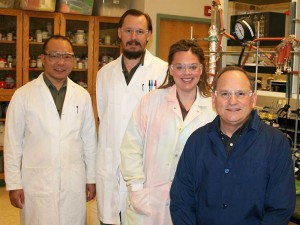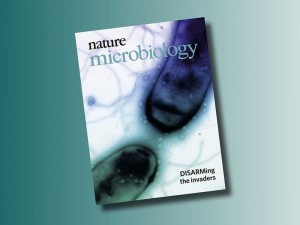Nature Has More Than One Way to Make Methane say USU Biochemists
US-Universities collaboration researchers report a bacterial, iron-only nitrogenase pathway for methane formation

USU biochemists, from left, Zhi-Yong Yang, Derek Harris, Rhesa Ledbetter and Professor Lance Seefeldt, along with collaborators, report a bacterial, iron-only nitrogenase pathway for methane formation.
Methane is a potent greenhouse gas, trapping more solar radiation on Earth than carbon dioxide. It’s also the primary component of natural gas, a critical fuel source for heating and other uses. For these reasons and more, scientists are keenly interested in how the gas is made.
A long-held assumption is that methane made by living organisms is made exclusively by a process called methanogenesis. Not so fast, say Utah State University biochemists, who, with collaborators from the University of Washington and Montana State University, report a bacterial, iron-only nitrogenase pathway for methane formation. Further the iron-only variant of nitrogenase can transform carbon dioxide into methane in a single, enzymatic step.

Members of USU’s Seefeldt Lab published in the Jan. 15, 2018, online edition of ‘Nature Microbiology.’ Their research is supported by the U.S. Department of Energy Office of Science’s Energy Frontier Research Center grant program.
USU biochemists Lance Seefeldt, Derek Harris, Rhesa Ledbetter and Zhi-Yong Yang, along with collaborators Carrie Harwood, Mary Lidstrom, Yanning Zheng, Zheng Yu, Yanfen Fu and Katie Fixen of the University of Washington; as well as Saroj Poudel and Eric Boyd of Montana State University, publish findings in the January 15, 2018, advance online publication of Nature Microbiology.
“Our findings are significant because they give scientists a second target to chase in understanding biological methane formation and rising methane emissions,” says Seefeldt, professor in USU’s Department of Chemistry and Biochemistry. “In addition, the discovery could drive efforts to turn waste gasses into usable fuels.”
The ability to accomplish large-scale capture of environmentally damaging byproducts from burning fossil fuel combustion into clean, alternative fuels has far-reaching benefits, he says.
“It’s currently a ‘holy grail’ of energy science,” says Seefeldt, an American Association for the Advancement of Science Fellow. “The knowledge we’re gradually gaining could be used to make fuels from waste gases, helping to improve the environment.”
The team’s work is supported by a grant awarded through the U.S. Department of Energy Office of Science’s Energy Frontier Research Center program to the Center for Biological and Electron Transfer and Catalysis or “BETCy.” Based at Montana State University, BETCy is a seven-institution collaboration, of which USU is a partner.
Source: Utah State University, press release, 2018-01-17.
